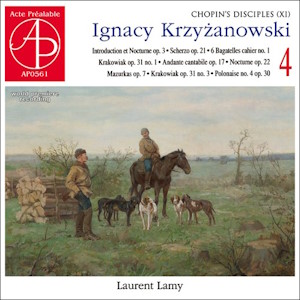
Ignacy Krzyżanowski (1826-1905)
Piano Works Volume 4
Laurent Lamy (piano)
rec. 2016/22, Polskie Radio Studio, Poland
Chopin’s Disciples (XI)
Acte Préalable AP0561 [68]
Laurent Lamy reaches the fourth volume in the complete piano music of Ignacy Krzyżanowski and I have to say that this is for me the most enjoyable so far. The format is the same as in the rest of the series (Acte Préalable AP0385, AP0463 and AP0551), a recital selected from various parts of his career and offering varied genres and moods. Rather than repeat the biographical details from earlier volumes I will just try to give a flavour of the works here. They include earlier works than have so far appeared in the series; the 6 bagatelles are described as his op.1 on imslp.org but the booklet merely says book 1 – book 2 can be heard on AP0551. As with that set these are short and simple with no great technical demands and seem like teaching pieces. There is a foretaste of the dance forms he was to focus on throughout his life such as the krakowiak, valse and polonaise with a gone-before-you-know-it tarantelle thrown in for good measure. The other two pieces are lyrical and sentimental. Far more substantial is his op.3 the Introduction et Nocturne; the introduction is virtuosic and dramatic and the nocturne starts off with a lilting and gentle melody. As soon as I heard it I was taken to the world of Donizetti or Bellini opera, the heroine or perhaps the hero striding to centre stage through the dramatic prelude and standing to sing their cavatina. After a while the keyboard figuration grows more decorative and complex and the stage fades to a single performer, a pianist playing his passionate transcription of the aria in the style of Liszt or Thalberg. The later Nocturne in D flat is equally attractive with its long cantilena in the style of Chopin. It has a contrasting minor section in 6/8 which, with a sudden modulation to F major, returns to the theme but now in 6/8 time. A short cadenza swings things back to the original key for a gentle reprise and conclusion. The andante cantabile op.17 has features common to both these pieces; the long melodic lines and operatic style. Under Lamy’s hands the open is almost barcarolle like and though
Krzyżanowski is his own man there are elements that remind one of Chopin, especially in the lyrical B major central section with its hints of the romance from Chopin’s E minor concerto.
Amongst the dances are two mazurkas op.7 to compliment the ten that have already appeared on earlier volumes (eleven if you count the bagatelle book 2 no.5). Both are boisterously rhythmic but share lyrical qualities too, notably the poco piu lento at the heart of the first. Krzyżanowski does not merely repeat the outer sections, he writes a harmonically interesting bridging section to return to the opening music. The muscular swagger of the second conceals a lilting heart and what would have been a beautifully delicate ending had not Krzyżanowski added four fortississimo accented chords to end in a grand manner. Moving from triple time to duple we have two krakowiaks, the first and third of Krzyżanowski’s three Chansons Polonais op.31 – the second appeared on volume one. These national dances are as vigorous as the mazurkas with plenty of humour in the rhythms of both pieces; the second takes the bare octave, minor key theme that opens proceedings and elegantly turns it into a lovely major key version. The third polish dance represented here is the polonaise; Krzyżanowski wrote at least six of these and one has appeared on each volume of this series. Lamy plays the fourth and so far my favourite. Echoes of Chopin? Yes certainly but they are less obvious than in his others and while no masterpiece Krzyżanowski’s use of rhythmic motifs, melody, keyboard range and texture is imaginative. I particularly like the way that the stately polonaise gives way to an elegant minuet in the middle section and on this occasion Krzyżanowski chooses an understated ending rather than going out with a bang. The Scherzo op.21 completes this recital. Any thought that Krzyżanowski was following Chopin’s example is dispelled immediately with the grave introduction, declamatory and with a descending note motif. The scherzo proper is more akin to the writing of Mendelssohn with a melody singing out over elfin semiquavers and it is the ballades of Chopin which seem to be influencing the writing in the more complex figurations and in the lilting barcarolle-like central section. This range of this extended and quite imaginative piece suggests a more narrative title than merely Scherzo and Romance or Ballade would seem to be more suitable. The central section is not just for contrast but also provides a development section and the whole is almost a sonata movement with a bravura ending.
The booklet continues the story of Krzyżanowski’s association with Chopin taken from a 1906 issue of the Poznan journal though this snippet tells mostly of Krzyżanowski’s initial lack of success in meeting up with the Polish master who appeared to spend little time with his countrymen at their usual haunts.
Once again Lamy does Krzyżanowski a service and for me appears to be building in stature as the series unfolds; there is some really beautiful playing here especially in the more tranquil moments, of which there are many, and he is not fazed by the technical challenges. A fine addition to Krzyżanowski’s growing discography.
Rob Challinor
Help us financially by purchasing this through MWI

Contents
Introduction et Nocturne in G major Op.3
Krakowiak in B major Op.31 No.3 (pub.1865)
6 Bagatelles Cahier 1 (pub.1925)
Deux Mazurkas Op.7 (pub.1861)
Nocturne in D flat major Op.22
Polonaise No.4 in D flat major Op.30 (pub.1873(
Krakowiak in B flat minor Op.31 No.1 (pub.1865)
Andante cantabile in E flat major Op.17 (pub. c.1856)
Scherzo in C minor Op.21 (pub.1861)


















